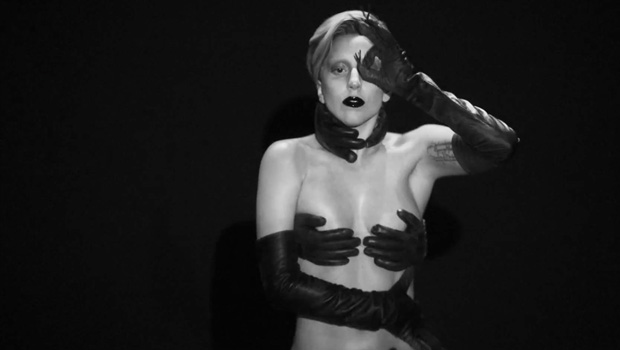By Chad Groom
Never a shrinking violet, Jean-Charles de Castelbajac brings noble rebellion to the intersection of fashion and art…
In this day and age where the average fashionista’s ABC’s consist primarily of hangtags from Armani, Balenciaga, and Celine, most may be more familiar with Jean-Paul Gaultier than with Jean-Charles de Castelbajac.

Unless you are a fashion fiend (or working your way through F.I.T.), de Castelbajac is arguably the lesser-known of the two French designers who both possess exotically-hyphenated first names; however, he is no sartorial slouch in comparison. If you’ve paid attention to fashion- even passively- in the last 40 years then you have seen his iconic work whether you realize it or not.
Whether it’s the interlocking leather gloves doubling as a makeshift bra cradling Lady Gaga’s breasts (with matching glove choker, of course!) in her “Applause” video or Eddie Murphy’s costumes in 1988’s chic-Afrique romantic comedy “Coming To America”, de Castelbajac has had many heady moments in his career. Whereas English androgyny-rocker David Bowie sought out Kansai Yamamoto for his iconic 70’s persona Ziggy Stardust, his fellow Brits Mick Jagger and Elton John headed to de Castelbajac. Even the Pope commissioned him to design vestments for over 5,000 priests upon their visit to Paris in 1997 for World Youth Day. Moreover, who can forget that coat made of 39 teddy bears that Madonna famously wore (and that supermodel Helena Christensen also donned in Robert Altman’s fashion-whodunit-of-a-movie, ‘Pret a Porter’). Lady Gaga- in an apparent nod to the coat made famous by Madonna- later had one of her first known de Castelbajac moments, wearing a dress made only of Kermit the Frog dolls. Need another major de Castelbajac fashion moment? How about Beyonce wearing his royal-blue silk bandleader’s jacket (replete with Swarovski crystals and tasseled epaulets) with equally-as-studded de Castelbajac platform stilettos while she cavorted around in the “Telephone” music video she shot with Lady Gaga?
His humble disposition betrays this French nobleman (no really, he is a marquis- born into aristocracy – in his native country!) He’s the ONLY person who holds the title of ‘Marquis’ who hails from the world of fashion. He has a cult following and has already had a retrospective of his work, entitled “POPAGANDA: The Fashion & Style of JC de Castelbajac” at London’s Victoria and AlbertMuseum back in 2006. Yes, his pieces were absolutely covetable in the 70’s and 80’s (teddy bear dress and an artistic stint at the sportswear label Iceberg, notwithstanding), yet he has managed to not just keep up with but direct the times to bend to his creative will. He seems to constantly surround himself with youthful, envelope-pushing individuals that both challenge and inspire him (and vice versa), toiling in the fashion trenches season after season to great affect for 53 magical years (so far).

However, one cannot accuse him of getting old. His Spring 2014 collection, dubbed “Art for Fashion’s Sake” (which seems to be his mantra throughout his career) was signature de Castelbajac. The opening look featured a shift dress covered in his bright free-hand art drawings. During the show a film was projected on the back wall, showing de Castelbajac- purportedly backstage- still painting the closing look (a long silk frock) right before the model appeared on the runway, dress still moist with paint, to stomp the catwalk and close the show. Highlights of the rest of the show included bright caftans in primary colors melded with linen and silk column dresses that boasted abstract “glove’ outlines across the body, de Castelbajac-style .
Le Marquis de Castelbajac infuses art on the ‘canvas’ of his pieces in the same way that designer Ralph Rucci splays images of artists Cy Twombly and Francis Bacon on his frocks. While de Castelbajac’s pieces may feel a little less high-brow than Rucci, they are no less fantastical. However, while Rucci uses the imagery of others, de Castelbajac uses his own. His signature strokes – which consist of semi-abstract faces and patterns in ebullient colors which can seem like a mélange of Keith Haring, Stephen Sprouse and Man Ray to some while others might see it as ‘Kandinsky on heroin’ or even Edvard Munch on a Qualuude- are hypnotic yet beautifully simplistic. It is these same faces you will see de Castebajac draw on furniture and fabric; settee benches, foot stools, entire swaths of canvas; nothing is off-limits in de Castelbajac’s world. A simple visit to his Instagram page (and his artistic web presence, www.jc-de-castelbajac.com) shows his consistency as both a designer and a fine artist; his touch is instantly recognizable. The new guard of designers who mix patterns and dabble in art (Muiccia Prada, Yayoi Kasama, and relative newbie Jeremy Scott to name a few) could stand to learn a thing or two from Castelbajac- if they haven’t already.





